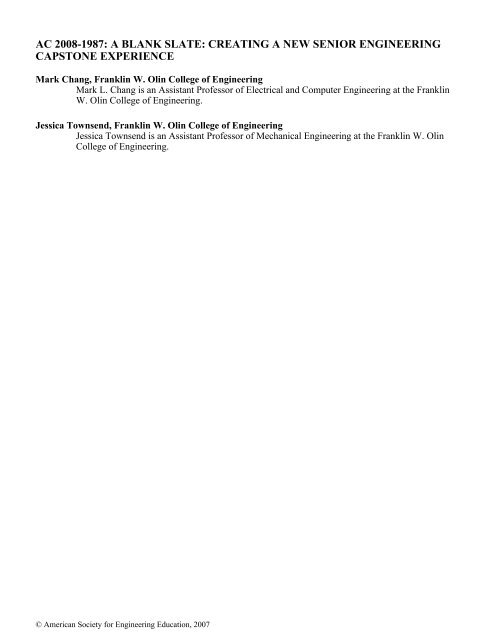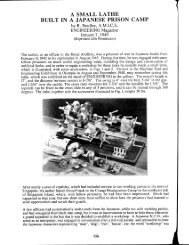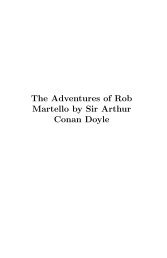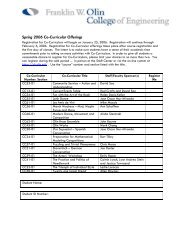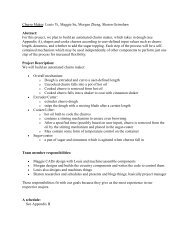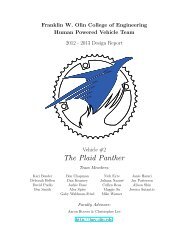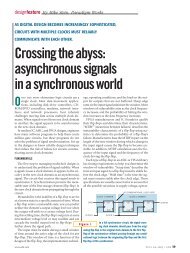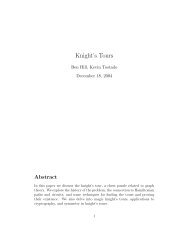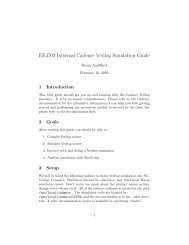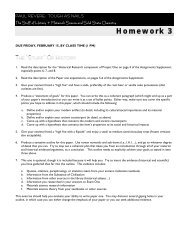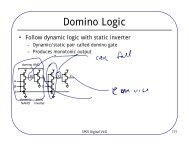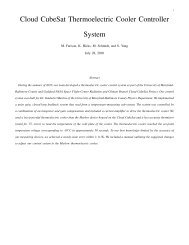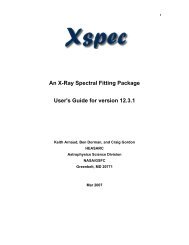ac 2008-1987: a blank slate: creating a new senior ... - Olin College
ac 2008-1987: a blank slate: creating a new senior ... - Olin College
ac 2008-1987: a blank slate: creating a new senior ... - Olin College
Create successful ePaper yourself
Turn your PDF publications into a flip-book with our unique Google optimized e-Paper software.
AC <strong>2008</strong>-<strong>1987</strong>: A BLANK SLATE: CREATING A NEW SENIOR ENGINEERING<br />
CAPSTONE EXPERIENCE<br />
Mark Chang, Franklin W. <strong>Olin</strong> <strong>College</strong> of Engineering<br />
Mark L. Chang is an Assistant Professor of Electrical and Computer Engineering at the Franklin<br />
W. <strong>Olin</strong> <strong>College</strong> of Engineering.<br />
Jessica Townsend, Franklin W. <strong>Olin</strong> <strong>College</strong> of Engineering<br />
Jessica Townsend is an Assistant Professor of Mechanical Engineering at the Franklin W. <strong>Olin</strong><br />
<strong>College</strong> of Engineering.<br />
© American Society for Engineering Education, 2007
A Blank Slate: Creating a New<br />
Senior Engineering Capstone Experience<br />
Abstr<strong>ac</strong>t<br />
This paper presents some of the challenges, successes, and experiences in designing a <strong>new</strong> <strong>senior</strong><br />
engineering capstone program at the Franklin W. <strong>Olin</strong> <strong>College</strong> of Engineering. Senior capstone<br />
design programs in engineering colleges have evolved over many years and are often modified<br />
and reinvented to keep up with the needs of both students and external constituencies. Harvey<br />
Mudd <strong>College</strong>’s Clinic program is one of the largest and longest-running capstone programs in<br />
the country that relies heavily on industry sponsors to provide real world problems and funding<br />
to execute the projects. For many reasons, and in no small way because of its tr<strong>ac</strong>k record of<br />
success, our own capstone course offering is modeled closely upon the Harvey Mudd Clinic<br />
program.<br />
However, completely importing a well-established program into a different context would be<br />
haphazard at best, and would ignore a unique opportunity to retool the program to meet the<br />
specific needs of a different college. This paper presents our experience in developing SCOPE,<br />
the Senior Consulting Program for Engineering at <strong>Olin</strong> <strong>College</strong>, and applying lessons learned<br />
from the Clinic Program and other successful capstone programs. We discuss the difficulties<br />
such as recruiting industry sponsors for a <strong>new</strong> and unproven program, developing assessment<br />
methodologies, and developing the policies and procedures needed to keep the program running<br />
smoothly and in a sustainable fashion. Through this narrative, the authors endeavor to inform<br />
other programs that are in need of modification, and educators who find themselves with the<br />
opportunity to start a capstone program from the ground up.<br />
<strong>Olin</strong> <strong>College</strong> B<strong>ac</strong>kground<br />
Franklin W. <strong>Olin</strong> <strong>College</strong> of Engineering is a <strong>new</strong>, four-year engineering school in Needham,<br />
Mass<strong>ac</strong>husetts. The college was started and funded by the New York-based <strong>Olin</strong> Foundation,<br />
which has awarded grants totaling more than $300 million to construct and fully equip 72<br />
buildings on 57 independent college campuses. Starting in the late 1980's, the National Science<br />
Foundation and engineering community at large started calling for reform in engineering<br />
education. In order to serve the needs of the growing global economy, it was clear that engineers<br />
needed to have business and entrepreneurship skills, creativity and an understanding of the<br />
social, political and economic contexts of engineering. The F.W. <strong>Olin</strong> Foundation decided the<br />
best way to maximize its imp<strong>ac</strong>t was to help create a college to address these emerging needs.<br />
The Foundation's commitment in excess of $400 million to <strong>Olin</strong> <strong>College</strong> remains one of the<br />
largest such commitments in the history of American higher education.<br />
The college officially opened in Fall 2002 to its inaugural freshman class. During the prior year,<br />
thirty student "partners" worked with <strong>Olin</strong>'s f<strong>ac</strong>ulty to create and test an innovative curriculum<br />
that infused a rigorous engineering education with business and entrepreneurship as well as the<br />
arts, humanities and social sciences. They developed a hands-on, interdisciplinary appro<strong>ac</strong>h that<br />
better reflects <strong>ac</strong>tual engineering pr<strong>ac</strong>tice. From the beginning, it was clear that a two-semester,
<strong>senior</strong>-year, engineering capstone project course would be part of the curriculum for all <strong>Olin</strong><br />
students. Just prior to the first year of instruction at <strong>Olin</strong>, the Curricular Decision Making Board<br />
put together plans for the <strong>senior</strong> year, and noted that “by the time students are <strong>senior</strong>s, they’ll be<br />
doing the real engineering on their own, in a year-long capstone project that will look very much<br />
like professional pr<strong>ac</strong>tice.” Development work on this program, eventually named SCOPE, the<br />
Senior Consulting Program for Engineering, began in earnest in the fall of 2004, when the first<br />
SCOPE Director was hired, Dr. David Barrett.<br />
The unique challenge, and, perhaps, the greatest advantage, in developing the SCOPE program<br />
was the absence of a pre-existing capstone program. The intent was to launch the SCOPE<br />
program during the first <strong>senior</strong> year offered at <strong>Olin</strong> <strong>College</strong>. Although an overall vision for the<br />
<strong>senior</strong> year had been developed, f<strong>ac</strong>ulty and administration needed to create and implement a<br />
fully-functioning capstone program so that the very first <strong>Olin</strong> <strong>College</strong> class would receive as<br />
close to the same capstone experience as those students that followed. <strong>Olin</strong> <strong>College</strong> is certainly<br />
not the first institution to develop a <strong>new</strong> engineering capstone program, therefore the most<br />
logical course of <strong>ac</strong>tion was to look at how other schools have run their capstone programs.<br />
Due in part to its similar mission, scale, and appro<strong>ac</strong>h to undergraduate engineering education,<br />
an obvious model for <strong>Olin</strong>’s capstone program is the Harvey Mudd Clinic Program. The Clinic<br />
Program is the longest running sponsored capstone program for undergraduates. For reasons<br />
detailed in later section, the Clinic Program became the blueprint from which the SCOPE<br />
program was designed.<br />
Goals of this paper<br />
In writing this paper, the authors intend to describe through a narrative, the history and evolution<br />
of the program over its first three years. The intention is to put the reader into the context of<br />
developing a capstone course from the ground up such that our experiences may inform the<br />
efforts of other f<strong>ac</strong>ulty and administrators seeking to build, expand, or enhance their own<br />
capstone programs.<br />
It is important for the reader to keep in mind that while this paper was written in consultation<br />
with f<strong>ac</strong>ulty and administrators involved in all aspects of the capstone program, it represents the<br />
interpretation of the challenges, successes, and experiences of many people by the two primary<br />
authors. We have made an effort to synthesize our observations with those of our colleagues, and<br />
would like to <strong>ac</strong>knowledge the hard work of all those involved in the design and execution of the<br />
program.<br />
The Harvey Mudd Clinic Program – A Major and Direct Influence<br />
Harvey Mudd <strong>College</strong> was founded in the mid-1950s. The original curriculum was strong in<br />
engineering science analysis, but engineering pr<strong>ac</strong>tice and professional training was l<strong>ac</strong>king.<br />
Specifically, students were not getting experience in solving open-ended problems, or with<br />
project and team skills. 1 The Harvey Mudd Engineering Clinic Program was started by<br />
professors J<strong>ac</strong>k Alford and M<strong>ac</strong>k Gilkeson in 1963 as a way to address these issues by bringing
eal-world engineering problems to the campus in a close approximation to professional<br />
engineering pr<strong>ac</strong>tice. 2<br />
The Clinic Program has been in operation for more than 40 years and has proven to be<br />
sustainable, both financially and logistically. Funding for Clinic comes directly from the<br />
sponsoring companies. Students work in four- or five-member teams, along with a f<strong>ac</strong>ulty<br />
advisor and a liaison from the sponsoring company on a project that is meaningful and useful to<br />
the sponsor. The students are responsible for developing the project statement, goals, and<br />
outcomes in concert with the sponsor liaison, and then are fully responsible for carrying out the<br />
project. The f<strong>ac</strong>ulty advisor is a mentor, co<strong>ac</strong>h, and assessor. The student teams give a number of<br />
design presentations to the Harvey Mudd <strong>College</strong> audience, the sponsor, and to the general<br />
public as part of the end-of-year Projects Day. 3<br />
The Evolution of SCOPE<br />
Year Zero: The First Steps in Developing the <strong>Olin</strong> <strong>College</strong> SCOPE Program<br />
In <strong>creating</strong> a <strong>new</strong> engineering college, the founding f<strong>ac</strong>ulty and administrators were presented<br />
with the unique challenge of wholesale invention of a four-year engineering curriculum. From<br />
the outset, every version of the <strong>Olin</strong> curriculum, “retained a two-semester <strong>senior</strong> capstone project<br />
course.” 4 At the conclusion of <strong>Olin</strong> <strong>College</strong>’s first sophomore year, it was clear that the succesful<br />
execution of a year-long, authentic, project-based experience would require significant planning<br />
effort. While there exist many models of capstone experiences, our then Dean of F<strong>ac</strong>ulty, Dr.<br />
Michael Moody, advocated the adoption of the Harvey Mudd Clinic Program as our model in his<br />
June 2004 memorandum on the upcoming <strong>senior</strong> capstone course. His experiences as Chair of<br />
the Mathematics department at Harvey Mudd, participating in the Math Clinic Program, and<br />
having signficant exposure to the Engineering Clinic Program, greatly influenced this decision.<br />
As a limitation of his experiences, and because of the anecdotal successes of the Clinic Program,<br />
this was the only model considered. By leveraging his direct experiences and intimate knowledge<br />
of a successful program, much of the work of “<strong>creating</strong>” the program was lessened. Dr. Moody<br />
remains a key leader in the continued evolution of our program, and his experiences were and<br />
continue to be invaluable to our efforts.<br />
In <strong>creating</strong> a sponsored program, two key decisions needed to be made which strongly<br />
influenced the rest of the program: the grant vehicle for sponsors to make monetary contributions<br />
to the program, and the dollar amount to charge for participation in the program. The fee for the<br />
program was set at $50,000, compared to approximately $41,000 for the Clinic Program in<br />
2006/2007. The justification and rationale for this price tag was that given the nature of our<br />
institution, we should be able to support a program of comparable complexity and cost to the<br />
Clinic Program. Specifically, given the high caliber of our students, the residential nature of our<br />
college, proximity to high-tech companies in the greater Boston area, our qualified f<strong>ac</strong>ulty and<br />
administration, and the two-semester capstone engagement structure, we believed to be in a<br />
position to offer an experience similar in scale to the Clinic Program. Our costs being higher than<br />
the Clinic Program come primarily from taking into <strong>ac</strong>count program startup costs.
With respect to the sponsorship vehicle, the program opted for a fairly complex contr<strong>ac</strong>tural<br />
agreement between the <strong>College</strong> (signed by students and f<strong>ac</strong>ulty advisers) and the corporate<br />
sponsor. This agreement addressed issues such as confidentiality, intellectual property rights,<br />
idemnification, and set baseline expectations for deliverables. It was felt that in the startup phase<br />
of the program, protecting the students and the <strong>College</strong> through a legally binding document<br />
would be preferred by both parties. This appro<strong>ac</strong>h received considerable thought and revision in<br />
later years.<br />
By April 2005, the program had been named SCOPE, and key personnel that would ultimately<br />
be responsible for the day-to-day execution of the capstone were chosen. This included the<br />
SCOPE f<strong>ac</strong>ulty, the student representatives, an external advisory committee, and the program<br />
director. Initial sponsor solicitation began, and two signed contr<strong>ac</strong>ts were in pl<strong>ac</strong>e with 30<br />
potential candidates being <strong>ac</strong>tively courted. It was at this point that the f<strong>ac</strong>ulty who were to<br />
participate in SCOPE starting in September of 2005 were notified. They were asked to target<br />
companies they would like to work with, help prioritize the current list of candidate sponsors,<br />
and help respond to <strong>new</strong> cont<strong>ac</strong>ts and projects.<br />
One unique aspect of the SCOPE program is the support of the Franklin W. <strong>Olin</strong> SCOPE Project.<br />
As <strong>Olin</strong> <strong>College</strong> itself is the result of a philanthropic organization, and e<strong>ac</strong>h of our students the<br />
recipient of philanthropy, it was important to provide an outlet for student philanthropy through<br />
engineering experiences. The Franklin W. <strong>Olin</strong> SCOPE Project was conceived of as a studentgenerated,<br />
<strong>Olin</strong>-funded SCOPE project of the same scale and level of technical challenge as a<br />
paying sponsor project. The vision was to have students craft detailed project proposals, of which<br />
one or two per year (depending on budget flexibility) would be selected and funded by the<br />
<strong>College</strong>.<br />
Reflections on Year Zero<br />
Development of Pedagogy: During the development year prior to the launch of SCOPE, a great<br />
deal of administrative energy was spent on soliciting potential sponsors. This focus, however,<br />
left many pedagogical issues untouched until the summer preceding the launch of the program<br />
when many of the f<strong>ac</strong>ulty responsible for advising teams and running the program finally joined<br />
the development effort. Important issues such as how to best utilize the class time within the<br />
weekly schedule, program-wide curricular milestones and objectives, common deliverables,<br />
grading and assessment rubrics and techniques, and team advising methods and techniques, for<br />
example, were only briefly discussed in meetings and drafted into the handbook before launch.<br />
After the program got underway, many of the details were either finalized just in time to be<br />
implemented, or the f<strong>ac</strong>ulty members were left to decide their own course of <strong>ac</strong>tion.<br />
In retrospect, there was not enough development time for f<strong>ac</strong>ulty before launch to permit a<br />
thorough investigation into what portions of the te<strong>ac</strong>hing tasks should be common between<br />
f<strong>ac</strong>ulty, and which portions were best left up to individuals to decide. A common struggle was,<br />
and continues to be, finding the balance between treating SCOPE as te<strong>ac</strong>hing multiple sections<br />
of the same course and therefore requiring common pr<strong>ac</strong>tices; versus <strong>ac</strong>knowledging that e<strong>ac</strong>h<br />
project is unique and therefore requires specific decisions regarding policies such as<br />
advising/mentorship and grading. Providing more time for f<strong>ac</strong>ulty development of the
pedagogical tools would significantly ease the anxiety of all parties, and would perhaps ensure a<br />
more even level of performance between teams.<br />
An important lesson learned was that although the adoption of the Clinic Program gave our<br />
program a strong and successful framework to build upon, it does not adequately inform the dayto-day<br />
operations and procedures that one must have to <strong>ac</strong>tually carry out the program. More<br />
preparation time and f<strong>ac</strong>ulty thought would have made the first year a much less anxiety-filled<br />
for all parties. This preparation would improve the chance for success in any program.<br />
Capstone Advising Committee: While the program had as a model the Clinic Program, one<br />
thing that we did not import from Harvey Mudd was an advisory committee. Harvey Mudd has<br />
an approximately 20-person advisory committee that includes members of the Board of Trustees<br />
and members from industry. Their purpose is to help sustain and improve the Clinic Program by<br />
providing feedb<strong>ac</strong>k to f<strong>ac</strong>ulty, staff, and students, and through conducting a satisf<strong>ac</strong>tion survey<br />
of the industry partners. While the SCOPE program has a very small handful of external<br />
advisors, they serve more in a technical advisory role for individual projects rather than aiding<br />
the program as a whole. While recruiting an advisory committee can be challenging, their<br />
presence could provide some useful and directed industry and <strong>ac</strong>ademic feedb<strong>ac</strong>k to improve our<br />
program. Without them, we run the risk of being short-sighted and limited in our contextual<br />
understanding of the corporate partner experience. We will soon be starting development efforts<br />
to create such an advisory committee for SCOPE.<br />
Contr<strong>ac</strong>ts: The contr<strong>ac</strong>tual agreement also received some criticism as the first summer of<br />
sponsor solicitations came to a close. While it was thought that a more industry-flavored contr<strong>ac</strong>t<br />
would make it easier for sponsors to agree to fund a project, in many instances, it was a<br />
bottleneck in negotiations. If we had used a less formal agreement mechanism—a letter of<br />
understanding, for example—the legal teams for the sponsors may have been less inclined to get<br />
involved. With the complex legal document we drafted, however, as it was clearly a contr<strong>ac</strong>t, it<br />
required the attention of the legal departments within potential corporate partners, slowing (and<br />
sometimes halting) negotiations.<br />
The agreement as a contr<strong>ac</strong>t also changes the psychology and expectations of the program as<br />
whole. With a firm legal document in pl<strong>ac</strong>e, sponsors might have felt the relationship more as a<br />
subcontr<strong>ac</strong>tor rather than primarily an educational partnership. This significantly alters the<br />
expectations of the sponsor and might put inappropriate pressures on the student teams.<br />
Successful Launch: In the positive, going into launch, the program was very successful in<br />
soliciting 13 paying external sponsors for a completely <strong>new</strong> and unproven program at an almost<br />
equally <strong>new</strong> and unproven institution. Much of the credit for this success is given to the tireless<br />
effort of Dr. David Barrett, the SCOPE program director. Coming directly from 25 years in<br />
research and industry, Dr. Barrett brought with him siginificant relationships with individuals<br />
and corporations in a position to sponsor a project. With a concrete capstone framework, Dr.<br />
Barrett could promote a well-structured and proven program that met corporate needs.<br />
Additionally, the college had received a large amount of media coverage during its startup years,<br />
and had already established itself as an engineering education innovator and a business-friendly
atmosphere. The general excitement surrounding <strong>Olin</strong> piqued interest among corporations<br />
looking for <strong>new</strong> ways to engage <strong>ac</strong>ademia.<br />
Year One: Off and Running<br />
The launch of the SCOPE program in the first week of September 2005 coincided with the last of<br />
the 13 contr<strong>ac</strong>ts being signed. In the summer months leading up to the launch, many of the<br />
mechanisms needed to successfully execute a project were put into pl<strong>ac</strong>e but never tested. The<br />
return of the students and the beginning of the SCOPE program would put not only our planning<br />
to the test, but also our ability, as a program, to be agile and adapt to the needs of the program. In<br />
this section we will reflect on the year’s experiences in three sections: curriculum and student<br />
experience, f<strong>ac</strong>ilities, and program & infrastructure. We will discuss some of the challenges and<br />
lessons learned in e<strong>ac</strong>h of these areas.<br />
Curriculum and Student Experience<br />
As previously mentioned, the amount of pedagogical preparation that was done prior to starting<br />
the program was not as much as any f<strong>ac</strong>ulty would have preferred. The negative imp<strong>ac</strong>t of this is<br />
perhaps minimized at our institution due to the f<strong>ac</strong>t that significant portions of the curriculum<br />
already involved large-scale projects and student-directed learning. The students had experience<br />
working with the unknown, and f<strong>ac</strong>ulty had experience leading and advising these efforts.<br />
However, it was still not decided when to treat the capstone as a single course taught by many<br />
f<strong>ac</strong>ulty, and when to treat it as a collection of completely separate and autonomous projects.<br />
While there is no correct answer, the vagueness was felt not only by the f<strong>ac</strong>ulty, but also<br />
experienced by the students, as individual f<strong>ac</strong>ulty led their teams in their own unique ways. In<br />
hindsight, it would have been useful to devote more time to discussing how the program could<br />
most effectively support these unique project experiences by enforcing uniformity in pl<strong>ac</strong>es, and<br />
encouraging autonomy in others.<br />
These decisions directly influence much of the student experience. Program <strong>ac</strong>tivities such as<br />
design reviews, assessment and grading, and f<strong>ac</strong>ulty-student inter<strong>ac</strong>tions are all areas that draw<br />
from either programmatic direction or from individul f<strong>ac</strong>ulty preferences. Without significant<br />
preparation, these many <strong>ac</strong>tivities become more ad-hoc in nature, and students’ motivation can<br />
suffer from the l<strong>ac</strong>k of coherency.<br />
It became more clear as the year progressed that maintaining student motivation was a key<br />
component to success. An area that could see improvement is in the scheduling of <strong>ac</strong>tivities,<br />
especially those toward the end of the second semester. As <strong>senior</strong>s start finalizing their postgraduation<br />
plans, having <strong>ac</strong>cepted job offers or gained admission in graduate school, motivation<br />
can be problematic. One lesson learned in our inaugural year was the importance of scheduling<br />
end-of-year events. In particular, the culminating final presentations to sponsor personnel was<br />
scheduled after finals. Many students found themselves “burned out” from their capstone<br />
experience, the crunch of finals for their other classes, the stress of graduation and impending<br />
major life changes, and simply the wear of four years of college. Positioning such a high-stakes<br />
and high-visibility event such as final presentations at a time when many students feel they<br />
should be celebrating can spell disaster.
Finally, in contrast to the Clinic Program, our students have no direct training in project<br />
management. The program offered several hours of instruction and guidance, but only to the<br />
student project coordinators. By introducing a required course in project management earlier in<br />
the curriculum, or by introducing formal instruction in various required project courses leading<br />
up to the capstone, our students might find managing their peers and interf<strong>ac</strong>ing with liaisons<br />
easier.<br />
F<strong>ac</strong>ilities<br />
After just a few weeks, it became clear that the capstone program’s imp<strong>ac</strong>t was not isolated to<br />
the f<strong>ac</strong>ulty and staff directly associated with the program. As projects moved forward, puchases,<br />
services, and sp<strong>ac</strong>e became more necessary. While the mechanisms for purchasing were already<br />
in pl<strong>ac</strong>e for the <strong>College</strong> as a whole, the disparate and frequent needs of the projects put a<br />
significant strain on purchasing personnel. Beyond purchasing, project needs found the students<br />
wanting physical sp<strong>ac</strong>e, computing resources, and IT resources that were not adequately planned<br />
for.<br />
All teams were assigned their own team room, a small office outfitted with tables and chairs, a<br />
whiteboard and a lockable file cabinet, but many projects required additional physical sp<strong>ac</strong>e to<br />
store, fabricate, and test devices. Some needs were modest and could be <strong>ac</strong>commodated in the<br />
team rooms or existing laboratories. However, the handbook had no guidelines for requesting<br />
rooms or other types of sp<strong>ac</strong>es, nor did the program have any significant predefined sp<strong>ac</strong>e<br />
allocated in advance. As is with most other colleges, excess sp<strong>ac</strong>e is rarely available. The process<br />
was therefore ad-hoc and required the involvement of many college administrators to help “find”<br />
sp<strong>ac</strong>e. This l<strong>ac</strong>k of immediate sp<strong>ac</strong>e influenced the student team’s ability to develop an<br />
appropriate statement of work in partnership with the sponsor liaison as they could not make an<br />
assumptions about having dedicated f<strong>ac</strong>ilities.<br />
A lesson learned here is that if at all possible, the program and college should find dedicated<br />
work sp<strong>ac</strong>es for some fr<strong>ac</strong>tion of the student teams with the assumption that some projects will<br />
have significant sp<strong>ac</strong>e requirements. Fortunately, the needs of the projects and the resources of<br />
the college came into alignment and physical sp<strong>ac</strong>e was temporarily granted when necessary.<br />
While physical sp<strong>ac</strong>e only affected a few teams, computing resources were a problem for a wider<br />
selection of teams. The nature of team-based engineering often requires sharing files between<br />
students, sharing files off campus, and purchasing high-performance workstations. In the first<br />
year, we did not adequately prepare our IT department for the flood of requests from student<br />
teams for support and equipment. Complex issues such as maintaining confidentiality of digital<br />
information on a network, issues of trademark and liability when making information publicly<br />
available on web sites, and advanced development that required different <strong>ac</strong>cess rules than<br />
typically allowed by the college network and computing infrastructure were not adequately<br />
addressed or anticipated. While we resolved the majority of these issues, it was a heavy<br />
additional burden on a separate department that could have been lessened with some planning.
Program & Infrastructure<br />
As it was our first attempt at executing a set of large-scale engineering projects for corporate<br />
sponsors, no amount of planning could have prevented some of the challenges detailed in this<br />
section. However, a lesson learned was that perhaps solving some of these issues beforehand<br />
might make the road to a <strong>new</strong> capstone program a bit smoother.<br />
Project confidentiality: In the first year of the program, we were not in a position to turn down<br />
many projects. Therefore, we found ourselves with several projects that had very restrictive<br />
confidentiality requirements. While the projects may have been successful and interesting, their<br />
closed nature prevented students from presenting much information regarding their work at<br />
design reviews. In addition to being logistically problematic, the students missed opportunities to<br />
get valuable feedb<strong>ac</strong>k on their work from anyone that had not signed the non-disclosure<br />
agreement.<br />
Cross-registered students: <strong>Olin</strong> <strong>College</strong> has a very close relationship with Babson <strong>College</strong> and<br />
Wellesley <strong>College</strong>, allowing Babson and Wellesley students to freely cross-register in nearly any<br />
<strong>Olin</strong> course, including the capstone. From our experiences this first year, it became clear that<br />
given the high-stakes nature of working on sponsored projects, having a system to screen for<br />
appropriate students was necessary. Having an adequate match between potential students in<br />
both interest and skill set would give the project a better chance of success.<br />
Human subjects policies and review: Due to the heavy design component of many of the<br />
projects, soliciting feedb<strong>ac</strong>k from volunteers at various stages of product development would be<br />
a common pr<strong>ac</strong>tice. Protecting these users from harm is an ethical requirement and responsibility<br />
of any college. We did not have the sufficient infrastructure in pl<strong>ac</strong>e to perform human subjects<br />
review of the work related to the capstone. In many cases, it was suggested that students follow<br />
the human subjects pr<strong>ac</strong>tices and requirements of their sponsoring company. However,<br />
sometimes the internal corporate review committees did not move at the p<strong>ac</strong>e necessary to be<br />
useful for a student team with a short time budget, and sometimes corporations had no internal<br />
review boards to leverage. Having a more program-wide solution to this need would be both<br />
educational and pr<strong>ac</strong>tical.<br />
Reflections on Year One<br />
As the f<strong>ac</strong>ulty looked b<strong>ac</strong>k over the first year of SCOPE, it became clear that <strong>Olin</strong> students were<br />
utilizing the design skills learned earlier in the curriculum in their SCOPE projects. In many<br />
ways, design is at the center of the engineering curriculum at <strong>Olin</strong>. All <strong>Olin</strong> students take Design<br />
Nature during their first year where they receive instruction in design processes and<br />
methodologies. During their second year they take a class called User Oriented Collaborative<br />
Design, which focuses on including the user in the design process. Many teams found that these<br />
design processes and the collaborative appro<strong>ac</strong>h were useful tools for their projects. Both f<strong>ac</strong>ulty<br />
advisers and program sponsors noted the teams’ strengths in this area.<br />
A second area of strength noted was the communication skills of the students, particularly when<br />
interf<strong>ac</strong>ing with the sponsor companies and during design reviews and presentations. This was<br />
likely due to the emphasis on oral communication and presentations throughout the entire <strong>Olin</strong><br />
curriculum and to the strong oral communication skills many students enter <strong>Olin</strong> with.
Finally, the students seemed able to handle many team dynamics issues on their own. The first<br />
<strong>senior</strong> class at <strong>Olin</strong> <strong>College</strong> had only 66 students, and most students were very aware of e<strong>ac</strong>h<br />
other’s work and communication styles going into the SCOPE program. This did not mean that<br />
team dynamics issues were non-existent, just that the teams had some skills to work through<br />
these kinds of issues already.<br />
An area of weakness noted by many f<strong>ac</strong>ulty advisers was the students’ willingness to take on<br />
hard analytical problems. There was a sense that students were capable of this level of work, but<br />
had difficulty in setting up the problem, making assumptions and working out a first order<br />
model. This was attributed not to a l<strong>ac</strong>k of open-ended problems in the curriculum, but to a l<strong>ac</strong>k<br />
of open-ended problems that required engineering science analysis.<br />
Although these issues that surf<strong>ac</strong>ed during the first year of SCOPE were regarded as important to<br />
address, it would be premature to make major changes to the program or to the <strong>Olin</strong> curriculum<br />
without more steady state data. The feedb<strong>ac</strong>k regarding analysis was given to f<strong>ac</strong>ulty responsible<br />
for te<strong>ac</strong>hing the engineering science classes, and some small changes were made<br />
programmatically. Most of the feedb<strong>ac</strong>k we received from Year One was incorporated through<br />
f<strong>ac</strong>ulty advising of teams. F<strong>ac</strong>ulty now had a year behind them and were able to bring those<br />
lessons learned, both on a team scale and a program-wide scale, to their advising. Having weekly<br />
SCOPE f<strong>ac</strong>ulty meetings provided the best opportunity to compare notes and share experiences.<br />
This is something that Harvey Mudd f<strong>ac</strong>ulty have noted as well, that learning to advise a Clinic<br />
Project is experiential learning for the themselves. The most valuable resource a <strong>new</strong> Clinic<br />
f<strong>ac</strong>ulty member can have is a solid group of experienced Clinic f<strong>ac</strong>ulty members to talk to. A<br />
cohort of dedicated f<strong>ac</strong>ulty members is what will keep a successful capstone program running<br />
and sustainable. 3<br />
Years Two and Three: Small Changes, Gaining Experience<br />
Much of the programmatic structure that was put into pl<strong>ac</strong>e during Year One was kept in<br />
subsequent years. One change made in Year Three was renaming the main student leadership<br />
position from “Project Coordinator” to “Project Manager.” The original intent was that the<br />
Project Coordinator would handle many of the administrative and sponsor communication duties,<br />
but would not necessarily be “managing” the other team members. It was expected that students<br />
would take responsibility for keeping up with their work and all team members would ensure<br />
that work was distributed fairly. During the first two years it became evident that students would<br />
not have a problem with one student managing the project and the work, and some students<br />
preferred this altogether. In the end, the position was renamed, but more emphasis was put on<br />
letting students rotate through this position during the one-year project. After one semester, this<br />
leadership scheme seems to be working well for the teams.<br />
There are several other major issues that the SCOPE Program has looked at and revamped over<br />
the first two and half years of the program. These are highlighted in the sections below.
Projects and Sponsors<br />
During Year Zero, the SCOPE Director spent many months on the road recruiting sponsors for<br />
the first year of SCOPE. The pitch to sponsors included a description of the types of projects that<br />
would have the biggest return on investment for the sponsors, and would also provide the most<br />
meaningful learning experience for the students. As the SCOPE Director explains, “All<br />
companies have three classes of problems. Class 1: are the mission critical problems that your<br />
best people must focus on for survival. Class 2: are the strategic problems that have been sitting<br />
on your b<strong>ac</strong>k burner for years, for l<strong>ac</strong>k of time and skilled labor to address them. Addressing<br />
these problems could significantly and positively affect your bottom line, provide a foundation<br />
for explosive growth or enable successful entry into a profitable <strong>new</strong> business area. Class 3: are<br />
low-level problems that have no significant imp<strong>ac</strong>t on your corporation’s operations.” When<br />
talking to potential sponsors, we emphasize that Class 2 problems are ideal for SCOPE projects.<br />
However, in the first few years of SCOPE, we did take on several projects that were not ex<strong>ac</strong>tly<br />
Class 2 problems. One project was done for a small start-up and involved development of a<br />
technology that was on a mission critical path for the company. In this case the f<strong>ac</strong>ulty adviser<br />
spent a lot of time managing the sponsor’s expectations of the outcome. Another project<br />
involved a technical analysis that was beyond the scope of the students’ abilities. The team spent<br />
the first semester attempting the problem and eventually went b<strong>ac</strong>k to the sponsor with evidence<br />
that the project was better suited for a PhD dissertation, and asked the company if they had<br />
another project they could t<strong>ac</strong>kle. In this case, the company responded well, brought another<br />
project to the table, and in the end was pleased with the students’ efforts.<br />
One way to help appropriately set sponsor expectations is in how the program is pitched. In our<br />
original efforts to recruit sponsors, we indicated that sponsoring a SCOPE team was very much<br />
akin to hiring five talented entry-level engineers who could make tr<strong>ac</strong>tion on a problem that that<br />
company did not have the resources to solve. After the first year, we adjusted our pitch to<br />
maintain more of a balance between a learning experience for the students and a benefit for the<br />
company. We also found that it became easier to help guide a sponsor towards an appropriately<br />
scoped project for our students.<br />
Finally, we learned that projects that are highly successful have an involved and <strong>ac</strong>cessible<br />
sponsor liaison (the company representative that interf<strong>ac</strong>es directly with the team).<br />
Design reviews<br />
All SCOPE teams are required to give regular design reviews to the <strong>Olin</strong> community throughout<br />
the year. The purpose and intent of the design reviews has changed over the three years of the<br />
program, with different f<strong>ac</strong>ulty advisers setting different expectations for their teams. In general,<br />
the purpose is to present technical issues and challenges, show progress, describe and justify<br />
design decisions and receive feedb<strong>ac</strong>k from the audience. The design reviews during Year One<br />
were not as inter<strong>ac</strong>tive as we would have liked, and in Year Two we told students that they were<br />
expected to contribute whether they were on the presenting team or not. However, during the<br />
first two years of the program, teams were expected to give design reviews every two weeks.<br />
This was taking time away from the technical work that needed to get done, and in Year Three,<br />
teams have been presenting twice a semester instead.
Grading and Assessment<br />
Prior to launching the program the SCOPE f<strong>ac</strong>ulty did not explicitly discussed grading and<br />
assessment. While course outcomes, grading criteria and deliverables were described in the<br />
SCOPE Handbook, no common method for assessment was presented. F<strong>ac</strong>ulty were encouraged<br />
to provide students with a mid-semester grade, but by the end of the semester it was clear that the<br />
methods of assessment for the SCOPE projects varied quite widely.<br />
The first major discussion of grading and assessment came at the end of the first semester of<br />
SCOPE where there was general agreement of what level of <strong>ac</strong>hievement e<strong>ac</strong>h letter grade<br />
indicated. In subsequent semesters, f<strong>ac</strong>ulty made progress in agreeing on a common set of<br />
deliverables and a common set of competencies and outcomes for SCOPE students. By the<br />
second year of SCOPE a set of peer assessment forms had been developed that were in use<br />
among most teams, and f<strong>ac</strong>ulty advisers were more clearly communicating their grading policies<br />
to their teams. However, it is fair to say that assessment does still differ among f<strong>ac</strong>ulty advisers,<br />
although more of an effort is made to streamline the assessment process, and f<strong>ac</strong>ulty are<br />
communicating with e<strong>ac</strong>h other more to maintain a similar set of expectations for their teams.<br />
Finding the Balance<br />
The creation of a capstone experience for our students was, and continues to be, a challenging<br />
effort that requires significant resources. In preparing this document, our goal was to discuss<br />
lessons learned along the way such that other programs seeking to incorporate <strong>new</strong>, or revamp<br />
existing, capstone programs would benefit from our experiences. One consistent theme in the<br />
struggle to make our program successful was finding the right balance between the investment of<br />
our sponsors and the expectations of our students. There are many f<strong>ac</strong>tors that contribute to this<br />
“balance”.<br />
Overall curriculum<br />
Matching the goals of the capstone experience to the content and trajectory of the entire<br />
curriculum ensures a better chance of success for our students. Set the bar too low, and the<br />
experience is not authentic. Set the bar too high, and the students struggle to succeed. Recruit<br />
projects with the wrong balance of technical challenges, design, and humanities, and our students<br />
will struggle. Match the project to the curricular goals of the college, and the students will<br />
flourish.<br />
Time in the <strong>ac</strong>ademic schedule<br />
Originally conceived, the program was 16 credit hours, essentially half the <strong>ac</strong>ademic workload<br />
for a year. This was scaled b<strong>ac</strong>k to 8 credit hours before launch. Balancing the time the students<br />
put into the project versus the expectations of the corporate partner is critical to success.<br />
Team resources<br />
Giving the students an appropriate budget and physical sp<strong>ac</strong>e to complete hard engineering work<br />
is critical to the students <strong>ac</strong>hieving success. While how much money and sp<strong>ac</strong>e a particular<br />
project needs varies significantly, ensuring that the program generates appropriate value for the<br />
sponsor is critical to sponsor happiness and sustainability of the program. It is important to<br />
recognize, however, that if simply measured against “consultant” efficiency, student teams will
not compare favorably. Providing value goes beyond the deliverables generated by the students<br />
to encompass philanthropy, recruiting opportunities, and investment in an <strong>ac</strong>ademic mission.<br />
F<strong>ac</strong>ulty advising<br />
F<strong>ac</strong>ulty must be engaged in the process and the outcome of the program, and given schedule<br />
sp<strong>ac</strong>e to dedicate time to the capstone as any other course. Without a dedicated and passionate<br />
adviser, the experience is not as rewarding for the students, and the work suffers as a result.<br />
Involved f<strong>ac</strong>ulty can also play a large role in sustainability—with successful projects, sponsors<br />
may be more willing to partner with individual f<strong>ac</strong>ulty long-term, easing the burden of finding<br />
sponsors.<br />
The sum of these f<strong>ac</strong>tors serves as a coarse indicator of how one might set the fee for corporate<br />
participation in the program. The more the college dedicates to the endeavor, the higher the<br />
valuation becomes. While it is not a simple task to balance this system, keeping it in balance can<br />
ensure a higher chance of sponsor satisf<strong>ac</strong>tion and program sustainability.<br />
Future directions<br />
In developing the SCOPE Program, the intent was to create an industry-sponsored capstone<br />
design program that would provide meaningful educational and professional experiences for our<br />
students, while providing enough value to the industry sponsors so that the program would be<br />
sustainable. In e<strong>ac</strong>h of the first three years, we have brought in enough funded projects for all the<br />
fourth-year students, and our program can be considered a resounding success if observed dayto-day.<br />
Much of this success is due to the tireless dedication of the current capstone director.<br />
Implementing a capstone course can give students a truly unique experience that can solidify<br />
their engineering education and propel them into the next stage of their careers. The costs to the<br />
college are as high as the rewards. Sustainability of the program is probably the biggest<br />
challenge we f<strong>ac</strong>e going forward. We have started to recognize that while a dedicated individual<br />
can be primarily responsible for the success in recruiting sponsors, more needs to be done to set a<br />
positive tr<strong>ac</strong>k record that will help us continue to recruit sponsors in the future. We remain<br />
cautiously optimistic that the continued short-term successes of the program will make sponsor<br />
recruiting easier and more sustainable.<br />
Bibliography<br />
1. J. R. Phillips and M. M. Gilkeson, “Reflections on a Clinical Appro<strong>ac</strong>h to Engineering<br />
Design,” Proceedings of The International ASME Conference on Design Theory and<br />
Methodology, Miami, FL, September 1991.<br />
2. A. Bright and J. R. Phillips, “The Harvey Mudd Engineering Clinic: Past, Present, and Future,” Journal of<br />
Engineering Education, 88 (2), 189–194, April 1999<br />
3. A. Bright, “Student, F<strong>ac</strong>ulty and Liaison Roles in the Engineering Clinic Program at Harvey Mudd<br />
<strong>College</strong>,” Proceedings of the 26 th Fundamentals in Education Conference, Salt Lake City, UT, November 1996.<br />
4. M. Moody, “Capstone Project Issues”, internal memorandum, June 6, 2004, revised June 15, 2004.


